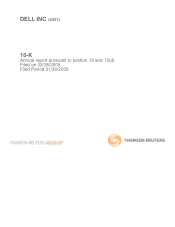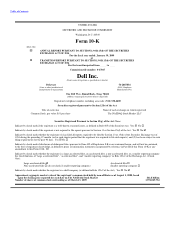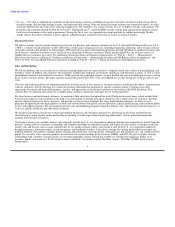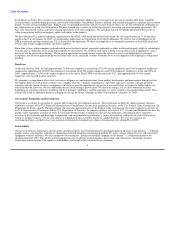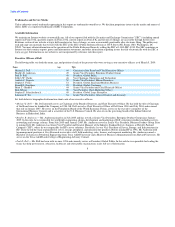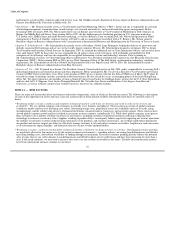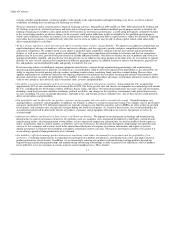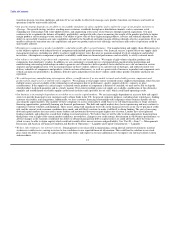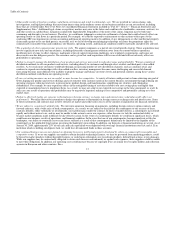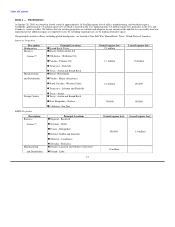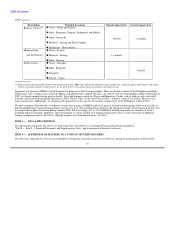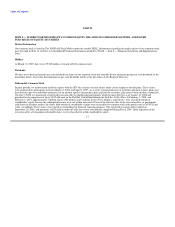Dell 2008 Annual Report Download - page 11
Download and view the complete annual report
Please find page 11 of the 2008 Dell annual report below. You can navigate through the pages in the report by either clicking on the pages listed below, or by using the keyword search tool below to find specific information within the annual report.
Table of Contents
In Fiscal 2008, we announced our commitment to becoming carbon neutral in our operations. We were the first company in our industry to offer a
free worldwide recycling program for our consumers. We also provided no-charge recycling of any brand of used computer or printer with the
purchase of a new Dell computer or printer. We have streamlined our transportation network to reduce transit times, minimize air freight, and reduce
emissions. When developing and designing products, we select materials guided by a precautionary approach. This means eliminating
environmentally sensitive substances (where reasonable alternatives exist) from our products and working towards developing reliable,
environmentally sound, and commercially scalable solutions. We also created a series of tools that help customers assess their current operations and
uncover ways to achieve their own environmental goals.
Backlog
We believe that backlog is not a meaningful indicator of net revenue that can be expected for any period. There can be no assurance that the backlog
at any point in time will translate into net revenue in any subsequent period, as unfilled orders can generally be canceled at any time by the customer.
Our business model generally gives us flexibility to manage backlog at any point in time by expediting shipping or prioritizing customer orders
toward products that have shorter lead times, thereby reducing backlog and increasing current period revenue. Even though backlog at the end of
Fiscal 2009 was higher than at the end of Fiscal 2008 and Fiscal 2007, it was not material.
Operating Business Segments
We conduct operations worldwide. Effective the first quarter of Fiscal 2009, we combined our consumer businesses of EMEA, APJ, and Americas
International (formerly reported through Americas Commercial) with our U.S. Consumer business and re-aligned our management and financial
reporting structure. As a result, effective May 2, 2008, our operating segments consisted of the following four segments: Americas Commercial,
EMEA Commercial, APJ Commercial, and Global Consumer. Our commercial business includes sales to large corporate, government, healthcare,
education, small and medium business customers, and value-added resellers and is managed through the Americas Commercial, EMEA
Commercial, and APJ Commercial segments. The Americas Commercial segment, which is based in Round Rock, Texas, encompasses the U.S.,
Canada, and Latin America. The EMEA Commercial segment, based in Bracknell, England, covers Europe, the Middle East, and Africa; and the
APJ Commercial segment, based in Singapore, encompasses the Asian countries of the Pacific Rim as well as Australia, New Zealand, and India.
The Global Consumer segment, which is based in Round Rock, Texas, includes global sales and product development for individual consumers and
retailers around the world. We revised previously reported operating segment information to conform to our new operating segments in effect during
the first quarter of Fiscal 2009.
On December 31, 2008, we announced our intent during Fiscal 2010 to move from geographic commercial segments to global business units
reflecting the impact of globalization on our customer base. Customer requirements now share more commonality based on their sector rather than
physical location. We expect to combine our current Americas Commercial, EMEA Commercial, and APJ Commercial segments and realign our
management structure. After this realignment, our operating structure will consist of the following segments: Global Large Enterprise, Global
Public, Global Small and Medium Business ("SMB"), and our existing Global Consumer segment. We believe that these four distinct, global
business organizations can capitalize on our competitive advantages and strengthen execution. We will begin reporting these four global businesses
once we complete the realignment of our management and financial reporting structure, which is expected to be in the first half of Fiscal 2010.
We have invested in high growth countries such as Brazil, Russia, India, and China ("BRIC") to design and manufacture products and support our
customers, and we expect to continue our global expansion in the years ahead. Our continued expansion outside of the U.S. creates additional
complexity in coordinating the design, development, procurement, manufacturing, distribution, and support of our increasingly complex product and
service offerings. As a result, we plan to continue to add additional resources to our offices in Singapore to better coordinate certain global activities,
including the management of our original design manufacturers and utilization of non-U.S. Dell and supplier production capacity where most needed
in light of product demand levels that vary by region. The expanded global operations in Singapore also coordinate product design and development
efforts with procurement activities and sources of supply. We intend to continue to expand our global capabilities as our international business
continues to grow. For financial information about the results of our reportable operating segments for each of the last three fiscal years, see
"Part II — Item 7 — Management's Discussion and Analysis of Financial Condition and Results of Operations — Revenues by Segment" and
Note 11 of Notes to Consolidated Financial Statements included in "Part II — Item 8 — Financial Statements and Supplementary Data." For
information about percentages of revenue outside the U.S. for each of the last three fiscal years, see "Part II — Item 7 — Management's Discussion
and Analysis of Financial Condition and Results of Operations."
Our corporate headquarters are located in Round Rock, Texas. Our manufacturing and distribution facilities are located in Austin, Texas; Winston-
Salem, North Carolina; Lebanon and Nashville, Tennessee; Miami, Florida; Limerick and Athlone, Ireland; Penang, Malaysia; Xiamen, China;
Hortolândia, Brazil; Chennai, India; and Lodz, Poland. For additional information, see "Part I — Item 2 — Properties."
7

